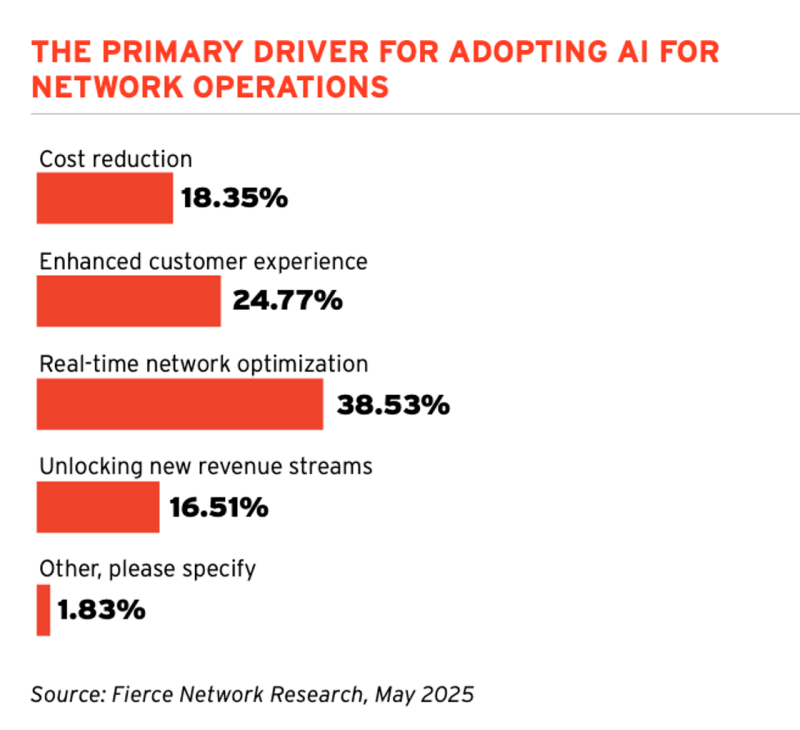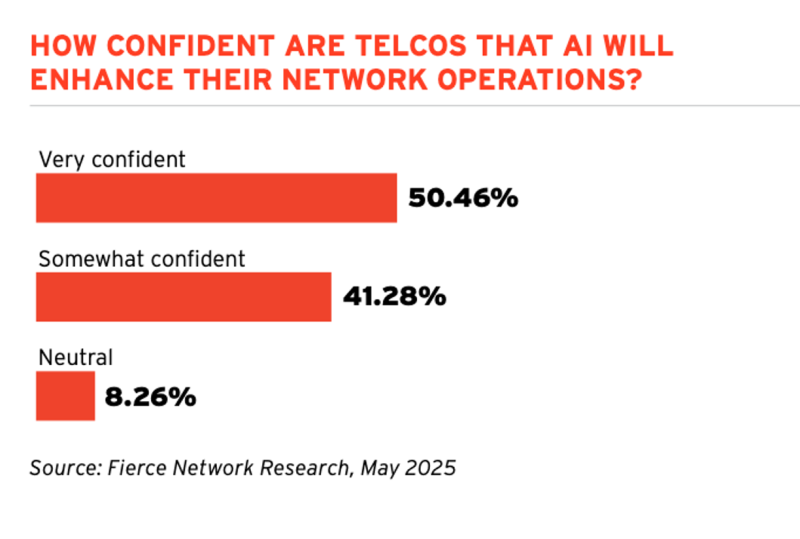- Telco leaders gathered at the Dallas Cowboys HQ to discuss how AI is reshaping their industry, at a live event by Fierce Network Research, sponsored by Supermicro and Nvidia
- Operators are optimistic but face major challenges, including legacy infrastructure and data complexity
- Survey shows strong momentum behind AI in, for and by the telco
AI is no longer a future bet for telecom — it’s a present-day imperative. At a Fierce Network Research live event in Dallas, we explored how AI is reshaping telcos from the inside out, from real-time network optimization to enterprise-facing AI services.
Telcos see AI as a chance to move beyond cost-cutting and into revenue growth. Our research finds operators deploying AI to automate operations, improve customer experience, and build entirely new enterprise offerings. But success isn’t guaranteed. Legacy systems, data quality, and organizational silos remain major barriers.
Some 50 telco technology decision-makers and influencers attending the event, which was co-sponsored by Supermicro and Nvidia. The event kicked off with a tour of the Dallas Cowboys training facility, located in the Star in Frisco, the Cowboys training center.
For those of you who know as little about sports as I do: The Cowboys are a football team. American football. When we planned the event, I suggested to my colleagues that we might choose a venue more likely to appeal to a mass audience, such as tours of the "Star Trek: Strange New Worlds" or "Doctor Who" TV sets, or maybe the Comic-Con Museum in my adopted home town of San Diego. My colleagues looked at me for a long time without making eye contact, and said, "OK, nerd, we'll think about that," and then pretended they did not hear me.
I kicked off the event with a brief presentation, delivering an overview of the state of AI for telcos. I wanted to start my presentation with a couple of football jokes. But because I am not a sports fan, I struggled. So I asked ChatGPT to suggest some jokes:
- "I'm not much of a sports guy, but I'm good at running ... late to meetings."
- "I'll try not to fumble ... the presentation."
- "If anybody can explain AI in a facility designed for professional athletes, it's a guy who gets out of breath walking to the podium."
What I did — asking ChatGPT for help — isn't unusual. More than half a billion people globally use AI chatbots daily, according to a June study by Menlo Ventures.
AI is transforming the world. And it's transforming telcos.
AI in, for and by the telco
That transformation can be divided into three categories:
AI in the telco. That's when telcos use AI to optimize their networks.
AI for the telco. Using AI for internal functions like customer service, billing and software development. AI for the telco is often similar to AI as used in any industry.
AI by the telco. Telcos offering AI as a service (AIaaS) for their customers, primarily enterprise customers, small and medium-sized businesses (SMBs) and government entities.
We've done multiple reports about telco AI at Fierce Network Research over the past year, including a survey of 109 telco executives in April and May about how they're deploying and thinking about AI. That report is, "AI and the Network: Telco leaders share insights about how AI is being used on the network," by me, my fellow analyst Linda Hardesty and edited by our editor-in-chief Liz Coyne.
Linda and Liz did nearly all the work. I did a little work and then swooped in at the last minute to grab credit.
Here's some of what we found:

Real-time network optimization was the number one driver for adopting AI for network operations, cited by more than a third of respondents. Enhanced customer reason was the second most popular driver, cited by nearly a quarter of respondents.
Next we asked respondents their biggest AI network operations challenge.

Legacy systems and infrastructure were cited as the biggest challenge by almost a third of respondents, with data complexity and quality at about a fifth. As Linda points out in her report, these responses are related. More than half of respondents are struggling with legacy infrastructure and data.
Despite challenges, telco executives are optimistic about AI.

Slightly more than half of respondents said they are very confident that AI will enhance their their network operations, and a little more than 2/5 said they're somewhat confident. So despite obstacles, more than 90% of respondents are feeling good about AI.
Let's give some examples of how telcos are using AI in each of our areas — AI in, for and by the telco.
AI in the telco

This is when telcos use AI to optimize their network and its operations.
3 Hong Kong, an operator run by Hutchison Telecom Hong Kong, is using AI for network operations to enhance customer experience, using AI to diagnose customer problems on their own network and other people's networks too.
If a customer has a problem with streaming music or video, the customer is going to blame the telco, even if the telco is not at fault.
It's not the telco's fault, but it is the telco's problem.
So 3 Hong Kong is using AI to diagnose and troubleshoot problems both on their own networks and the public internet. They can reach out to a streaming provider and work together as partners to solve customer problems.
This is a prime example of culture shift required for modern telcos. Telcos ned to think about customer experience rather than network metrics.
Network operations teams traditionally concern themselves with network metrics, such as throughput, dropped call rate or error rate. But customers don't know about network metrics — they know about their own experience.
In another example, in June, we saw Cisco debut its AI Assistant for network operations. This AI tool automatically identifies network issues, diagnoses root causes and automates workflows, presenting solutions to human operators for approval. It uses a chat interface and network diagrams to interact with users.
Cisco showed a demo of the AI Assistant, and it was wild. Although it was a text chat interface, it was like every episode of "Star Trek" where Mr. Spock talks to the ship's computer and the computer talks back. It was really cool.

Nvidia is doing something similar with its Large Telco Model, introduced this spring along with a number of partners, including SoftBank.
While the large language models (LLMs) that power chatbots like ChatGPT and Claude are stores of general knowledge, the Large Telco Model focuses in particular on telco issues.
Rakuten Mobile is another company using AI to optimize network operations. Instead of network engineers creating Key Performance Indicators (KPIs) as a baseline for acceptable network performance, Rakuten Mobile just uses raw network data. The AI doesn't need the KPIs, it can just watch the raw data directly. That streamlines network operations.
AI for the telco
A lot of interesting work is being done implementing AI in customer service and customer experience management. 3 Hong Kong's work falls into this category.
Customer service is a particularly fertile ground for improving with AI.

Amdocs and Nvidia are implementing digital avatars coupled with LLMs for customer service. These are video avatars that customers can talk to in natural language for tech support and sales. They look and act like real people on video.
Customer satisfaction surveys show that customers prefer those interactions to dealing with chatbots.
Interestingly, research done at the Kelly School of Business at Indiana University shows that people swear less severely at AI avatars than they do when frustrated by regular chatbots. Frustrated customers still swear, but the language is less harsh.

A guy with a really long job title
Globe Telecom is building a reusable AI infrastructure to avoid vendor lock-in and streamline complex deployments.
Speaking at the TM Forum DTW Ignite conference in Copenhagen in June, Anton Reynaldo Bonifacio, Globe Telecom executive vice president, chief information security officer and chief AI officer, used a kitchen metaphor for describing the infrastructure they're building for AI.
(During my presentation, I had to take a deep breath to get all the way through Bonifacio's title.)
Imagine you needed a different kitchen for every type of dish you cooked — Chinese food, steak, Italian food, Japanese food, Mexican, etc. That would be crazy. You’d have separate appliances and partners. You end up with — as Bonifacio put it — ”the same nightmare we're in now, where you've got vendor-locked, overlapping technologies.”
Instead, Globe Telecom built a centralized, shared AI "kitchen" for business units. Reusable "appliances" include common AI landing zones, which are pre-configured cloud environments designed to help quickly and securely deploy AI workloads. Also included are an observability stack, LLM guardrails, data and Terraform scripts, with a strong focus on security throughout.
AI by the telco

AI by the telco is AI as a Service (AIaaS), primarily for enterprise, SMB and government customers.
In one example, we're seeing telcos around the world implementing AI factories — data centers optimized for delivering AI outcomes. Demand for these factories is driven to a large degree by AI sovereignty regulations that require AI to be done within national or regional borders, in the European Union and elsewhere.
We did a big report on AI sovereignty and AI factories in February, and at that time, found more than 15 telcos around the world are implementing AI factories with investments for each of them stacking up as high as hundreds of millions of dollars. "AI sovereignty: Seizing the opportunity for transformative telco infrastructure investment."
Orange Business is making a strategic commitment to AI, supporting enterprise AI at every layer — SD-WAN and security services for connectivity, private cloud for data and AI sovereignty, and a platform called Live Intelligence to help enterprises of different sizes build generative AI systems. Orange has 73,000 of its own employees using Live Intelligence.
Usman Javaid, Orange Business chief product and marketing officer, told us AI is "one of the few lifelines left for the telco industry." After years of focusing on cost-cutting and efficiency, AI can help telcos grow revenue.
Fierce Network Research's take
Telcos have many advantages in implementing AI. Physical real estate, including data centers and central offices, gives telcos proximity to the network edge, where enterprise customer data lives and where enterprises need to implement AI.
Networks are supremely important assets, of course.
Telcos have relationships with national and regional governments, which are becoming more important in this geopolitically fractured world.
They have trusted relationships with local businesses. And they have industry knowledge — they know how their business customers do business.
The telecom industry is at an inflection point. AI isn’t just another tool—it’s the foundation for the next phase of telco relevance and growth. Operators that move quickly to modernize infrastructure, embrace new service models, and integrate AI across their organizations will lead the industry forward. Those that hesitate will find themselves left behind.